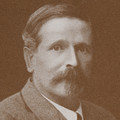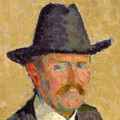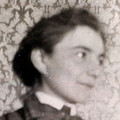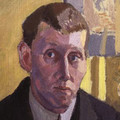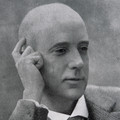Frank Rutter, Preface: ‘The Camden Town Group: A Fragment of History’
in The Camden Town Group: A Review, exhibition catalogue, Ernest Brown & Phillips, The Leicester Galleries, London, January–February 1930, pp.7–11.
THE CAMDEN TOWN GROUP
A Fragment of History
IN the winter of 1910–11 a number of us had formed the habit of dining on Saturday evenings at a now vanished hotel-restaurant in Golden Square. The most regular in attendance were Harold Gilman, Spencer Gore, Augustus John, J. B. Manson, Lucien Pissarro, Walter Sickert and myself. Soon after the habit started we were joined by Charles Ginner, and afterwards by R. P. Bevan.
These dinners were a prelude to nights at the Café Royal, and a sequel to afternoons at 19, Fitzroy Street, where for some years previously Sickert had held court with a floating and fluctuating population of artists.
For many Saturdays the principal topic of conversation was the rejection by the new English Art Club of certain pictures which, the diners thought, ought to have been accepted. Gradually these weekly conversations grew into a debate when the question before the House was whether it was better to endeavour to reform the New English by capturing a majority on the Selection Committee, or whether it would be better to start an entirely new society.
John, I remember, was always intensely loyal to [end of p.7] the New English, and in favour of the former alternative. Pissarro was inclined to support him, but was a little sceptical as to the possibility of the capture. Gilman was tooth-and-nail against any compromise with the enemy, and was definitely in favour of founding a new exhibiting body. Gore supported Gilman in principal, but, characteristically, voiced his arguments in a gentler and milder manner. Sickert, with his usual broad-mindedness, saw both sides of the question, and stated them alternatively with equal brilliance and esprit.
Eventually the persistence of Gilman triumphed. It was decided to found a new society, which held its first exhibition at the Carfax Gallery in June, 1911. Gore was elected President.
That year there had been a particularly well-advertised murder in Camden Town, and I think it was Sickert, who already had some connection with that district, who suggested that the new society should be called “The Camden Town Group.” To keep up the association Sickert contributed to the first exhibition two genre subjects, entitled “The Camden Town Murder,” one of which was afterwards exhibited as “Father Comes Home,” and ultimately sold, I understand, as “The Germans in Belgium.” Otherwise, to the inquiry, “Why Camden Town?” the correct reply was “Because some of the members live at Hampstead, and others at Hammersmith and Chelsea.”
In addition to the eight artists already mentioned, eight others contributed to the first exhibition of [end of p.8] The Camden Town Group. Walter Bayes I had introduced to Sickert in 1908, in connection with the Allied Artists’ Association, through which Bevan and Ginner had also come into the Fitzroy Street circle. Malcolm Drummond, J. D. Innes and Henry Lamb were already there. Gilman and Gore brought in P. Wyndham Lewis and W. Ratcliffe, also, I fancy, M. G. Lightfoot, a young painter of great promise, who died that same year before the second exhibition in December. The sixteenth exhibitor was J. Doman Turner, an amateur in water-colour – afflicted with deafness – whom I had introduced to Gore, who subsequently taught him painting by correspondence, in a series of wonderful letters, which should still exist somewhere.
In the second exhibition, also held at the Carfax Gallery, in December, 1911, there was no change of membership, except that Duncan Grant replaced Lightfoot, and sent one picture, “Tulips.” John remained a member, but did not exhibit. In the third exhibition, held at the Carfax in December, 1912, the membership was exactly the same, but Duncan Grant, Innes and John did not exhibit.
In 1913 a crisis arose. The exhibitions had not been successful financially, few works had been sold, and the director of the Carfax Gallery was disinclined to continue them. Consequently no exhibition was held by the Group in that year.
Early in 1914 some of the members approached the late Mr. Marchant of the Goupil Gallery, who [end of p.9] already knew many of the “Camden Town” painters. He received their proposals with sympathy, but having larger premises he wanted a considerably larger exhibition. Also, with his essentially aristocratic tastes, he was not enamoured of the title of the society.
One of the most stringent rules of the Camden Town Group had been that no women painters were eligible. When it was decided to increase the membership this rule was rescinded, and Miss Jessie Etchells, Mme. Renée Finch, Miss Silvia Gosse, Miss A. H. Hudson, Mme. S. de Karlowska (Mrs. Bevan), Miss Therese [sic] Lessore and Miss Ethel Sands were admitted. Also it was decided to include sculpture, so Gaudier-Brzeska and Epstein – both of whom served on committees of the Allied Artists’ Association, and there came into close contact with members of the Group – were elected.
Meanwhile, Wyndham Lewis had started his “Vorticist” centre in Great Ormond Street, where he had gathered round him another group of artists. A junction was effected, which brought Messrs. Bomberg, Etchells, C. F. Hamilton, Nevinson and Edward Wadsworth into the Camden Town circle. Innes died in 1914, and Augustus John – who had always been lukewarm in his support – retired. Lucien Pissarro, who felt out of sympathy with the Vorticist recruits, remained nominally a member for a while, but did not exhibit again. Doman Turner also disappeared. In their stead Messrs. Adeney, John Nash, Harold [end of p.10] Squire and Harold Sund (Mme. Finch’s husband) were elected, also the two amateurs and collectors, the late D. Fox-Pitt – who did so much for the Brighton Art Gallery – and his alter ego Walter Taylor. Thus the membership was increased from sixteen to thirty-two. Finally Harold Gilman was elected President in place of Spencer Gore, and the title of the society was changed to that of “The London Group,” whose first exhibition was held at the Goupil Gallery in March, 1914. Thus ended the Camden Town Group, but at least its spirit continued to animate its offshoot so long as Gore and Gilman lived.
Frank Rutter.
How to cite
Frank Rutter, Preface: ‘The Camden Town Group: A Fragment of History’, in in The Camden Town Group: A Review, exhibition catalogue, Ernest Brown & Phillips, The Leicester Galleries, London, January–February 1930, pp.7–11, in Helena Bonett, Ysanne Holt, Jennifer Mundy (eds.), The Camden Town Group in Context, Tate Research Publication, May 2012, https://www

